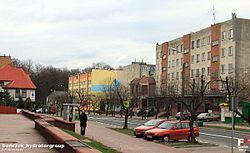Town rights 1748 Area 35.7 km² Local time Saturday 2:36 AM | Established 11th century Time zone CET (UTC+1) Population 19,962 (2013) | |
 | ||
Weather 2°C, Wind W at 8 km/h, 96% Humidity Voivodeship Świętokrzyskie Voivodeship | ||
Końskie [ˈkɔɲskʲɛ] is a town in central Poland with 20,328 inhabitants (2008), situated in the Świętokrzyskie Voivodeship (since 1999), previously in Kielce Voivodeship (1975–1998). Most of the town labour force was employed in the local foundry (Koneckie Zakłady Odlewnicze) in the late 1980s and early 1990s. Since 1997 the town has developed into a major trade centre for small business. Historically, Końskie belongs to the province of Lesser Poland, and since its foundation, until 1795 (see Partitions of Poland), it was part of Lesser Poland's Sandomierz Voivodeship.
Contents
- Map of Konskie Poland
- History
- World War II
- Jewish history of Koskie
- Notable buildings and landmarks
- Famous people born in Koskie
- Twin towns Sister cities
- References
Map of Konskie, Poland
History
The oldest settlement which is now Końskie dates back to the 11th century. The burial ground from this period was discovered in the north part of the town in 1925. Końskie was mentioned in historical sources in 1124 for the first time, with Prandota of Prandocin (the progenitor of Odrowąż family) recorded as the owner of the settlement. For the next few centuries the settlement was owned by the Odrowąż family. Iwo Odrowąż, the bishop of Kraków, founded a parish and built a church dedicated to St. Nicholas in years 1220-1224. The church was torn down in the 15th century and a new Gothic one was built in its place in the years 1492-1520. Some elements of the older Romanesque church were saved in the new one (e.g. the Romanesque tympanum, pictured). Końskie received city rights from King August III Sas on December 30, 1748.
World War II
Końskie was briefly visited by Adolf Hitler on September 10, 1939 while on the way to Kielce after landing on an airfield nearby. His car cavalcade visited the headquarters of General Walther von Reichenau at the local mansion. Hitler was followed by director Leni Riefenstahl who came a day later, ordered to film the Nazi German victory over Poland. Reportedly, she fainted when witnessing the random killing of two dozen Jews summoned to dig graves on September 12, 1939 (pictured).
Końskie was the centre of Polish underground resistance during World War II, with battles fought by the Armia Krajowa under Major Henryk Dobrzański ("Hubal") in the nearby forests which the German army feared to enter. The town was taken over by the partisans for a few hours on the night of September 1, 1943, with a number of Gestapo agents assassinated. The Nazis retaliated by executing civilians including Jews.
Jewish history of Końskie
The first mention to the Jewish community in Końskie dates back to the 16th century. The pre World War II Jewish population of Końskie (known as Koinsk during the Russian occupation or Kinsk in Yiddish – קינצק / קינסק among the Jews) comprised 60.6% of the total population of the town or about 6,500 persons in September 1939. After the Nazi German invasion of Poland, a Ghetto was established in 1940 and closed off in the spring of 1941. The complete eradication of the Jewish population of Końskie took place on November 3–9, 1942, when all men, women and children were loaded onto Holocaust trains to Treblinka II and gassed to death. Approximately 600 Jews were murdered by the Nazis on the way to the camp. In the subsequent January 1943 "Aktion" in the Konskie Ghetto, remaining Jews were ferreted out from attics and other hiding places and murdered.
Koinsk appears under the name Bociany as the setting for Chava Rosenfarb's Yiddish language novel of the same name. Bociany was published in English in the author's own translation by Syracuse University Press 2000. The translation won the John Glassco Award for Literary Translation in 2000.
The Koinsk Organization of Israel ("Ha'Ayarah She'Li: Sefer Ha'Zikaron Le'Yehudei Konskiyah, Hebrew, 2001) commemorates the tragic death of the Jews of Konskie every year at The Diaspora Museum close to the 25th of the Jewish month of Cheshvan.
Notable buildings and landmarks
Famous people born in Końskie
Twin towns — Sister cities
Końskie is twinned with:
